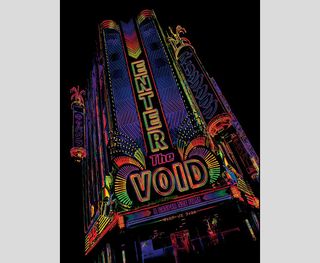6 Reasons Enter The Void Will Shake Cannes
Gaspar Noe on his Irreversible follow-up…

Enter The Void...
Enter The Void was confirmed for Cannes today and we’re insanely excited. And not just because fanboys are already describing it as “Gaspar Noe’s 2001.”
Irreversible director Noe has been working on the super secretive project for fifteen years now, and as it’s showing at Cannes, he’s ready to start talking about it.
What follows is Noe’s own thoughts on the film, alongside the very first images.
Be warned, pictures of strippers, drug taking, bloody hands and weird neon cities are to follow…

Enter perception and consciousness...
"Few of the arts can satisfy man’s need to be uplifted as immediately as film. And none (except interactive video games) can yet reproduce the maelstrom of our states of perception and consciousness.
In the past, certain films have tried to adopt the subjective point of view of the main character. Enter The Void will try to improve upon its predecessors and accompany the hero just as much in his normal state of awareness as in his altered states: the state of alertness, the stream of consciousness, memories, dreams..."

Enter hallucinatory experiences...
"The visions described in the script are inspired partly by the accounts of people who have had near-death experiences, who describe a tunnel of light, seeing their lives flashing past them and ‘astral’ visions, and partly by similar hallucinatory experiences obtained by consuming DMT, the molecule which the brain sometimes secretes at the moment of death and which, in small doses, enables us to dream at night.
The film should sometimes scare the audience, make it cry and, as much as possible, hypnotise it."

Enter an emotional journey...
"In recent years, films with labyrinthine structures have proved the audience’s ability to follow storylines in the form of a puzzle, and its desire to move away from linear narration.
But a complex form where the content does not move the spectator in any way would only amount to mathematic virtuosity.
Whereas this film is above all a melodrama: the universal melodrama of a young man who, after the brutal death of his parents, promises that he will protect his little sister no matter what and who, sensing that he himself is dying, fights desperately to keep his promise.
A film where the life of one person is linked to the love he has for another human being."

Enter Tokyo...
"The reason for choosing the most modern areas of Tokyo as a setting is to further emphasize the fragility of the brother and sister by propelling them like two small balls in a giant pinball machine made up of black, white and fluorescent colours."

Enter a great film...
‘Making a film is difficult, but making a great film is an almost impossible task.’
"This quote from Spielberg is perhaps not completely accurate, but that’s how I remember it. However, some examples of great films do exist, including the film which had such an influence on my existence: 2001, A Space Odyssey.
Without professing to be able to create such a masterpiece, trying to make a film that is, at the same time, a large-scale entertainment, suitable for adults and complex in cinematic terms, is one of the most exciting undertakings one could wish to tackle.
And if one does not set out with the aim of making a great film, one can be sure that it will not turn out to be one."

Enter the rollercoaster...
"My previous two films, which were far less ambitious, were once described by a critic as being like roller coasters playing with the most reptilian desires and fears of the spectator.
Enter The Void, whose themes and artistic choices will be far more varied and colourful, should, if I succeed, be the Magic Mountain which I, as a spectator, dream of riding on."
Sam Ashurst is a London-based film maker, journalist, and podcast host. He's the director of Frankenstein's Creature, A Little More Flesh + A Little More Flesh 2, and co-hosts the Arrow Podcast. His words have appeared on HuffPost, MSN, The Independent, Yahoo, Cosmopolitan, and many more, as well as of course for us here at 12DOVE.
Most Popular
